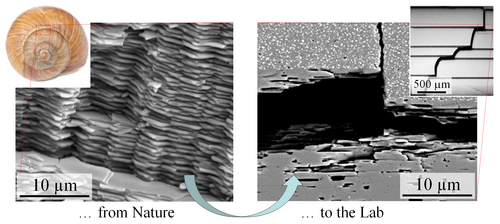Project Description “CERATEXT”
Advanced ceramics incorporate multifunctional design and innovation to produce high-performance applications in the fields of biomedicine, automotive engineering, electronics, energy and mechanical engineering. The combination of ceramics with other materials (metals, polymers or other ceramics) has enabled the fabrication of hybrid systems with exceptional structural and functional properties. Examples are bio-implants for hip joint replacements, piezo-ceramic actuators in car injection devices, resistors and capacitors in microelectronics, batteries or solid oxide fuel cells for energy storage, among others. However, a critical issue affecting the functionality, lifetime and reliability of these systems is the initiation and uncontrolled propagation of cracks in the brittle ceramic parts, yielding in some cases very high rejection rates of component production. In contrast to metals and polymers, crack propagation in ceramics is usually catastrophic due to their high stiffness and lack of plastic deformation upon loading. As a result, ceramics have low tolerance to damage. In this regard, the remarkable “damage tolerance” found in natural materials such as wood, bone or mollusc shells, has yet to be achieved in technical ceramics. You can replace a mobile phone, but we do not want a fracture of a hip-joint or a ceramic sensor that fails in an “autonomous car”. Novel “bio-inspired” ceramic designs combining microstructure and architecture could change this situation.
CERATEXT aims to establish new scientific principles for the design and fabrication of innovative ceramics with unprecedented damage tolerance and high reliability. The main strategy is based on tailoring microstructural features (e.g. texture degree, tailored internal stresses, second phases, interface bonding) in a hierarchical architecture, in order to provide outstanding lifetime and reliability in structural and functional ceramic devices.
Name (gender) | Degree | Nationality | Entering project | Status | Main activity |
I. Kraleva (f) | MS | BU | 1.5.2019 | current | Ceramography, Fractography |
J. Schlacher (m) | MS | AT | 1.8.2019 | current | Components design, Mechanical testing |
R. Papsik (m) | MS | CZ | 1.9.2019 | current | Modelling, Analysis |
A.-K. Hofer (f) | MS | AT | 1.4.2020 | current | Processing, Sintering, Characterization |
A. Jabr (m) | MS | AT | 1.1.2020 | current | Mechanical testing |
M. Wratschko (f) | BA | AT | 01.03.2021 | 30.09.2021 | Processing and Characterization |
L. Bastos (f) | BA | BR | 01.01.2022 | current | Ceramography |
J. Cardenas (m) | BA | CO | 01.01.2022 | current | Processing |
- Fabrication of high-strength alumina ceramics (more than 1GPa) using Additive Manufacturing, by combining alumina layers with internal alumina-zirconia composite layers. (See Paper below)
- We have demonstrated for the first time that it is feasible to “texture” alumina ceramics using Additive Manufacturing stereolithographic methods. (See Paper below)
- Initiation of collaboration with the company Lithoz, leader in 3D printing technologies for ceramics. We have entered the 3D printing community, showing the potential of exploiting the concepts of the ERC-project also for Additive Manufacturing technologies.
- Press release in “3dprintingmedia.network” Magazine: this article advertised our results all over the scientific and industrial community on 3D printed ceramics and materials in general. Visit: https://www.3dprintingmedia.network/austrian-researchers-demonstrate-strongest-3d-printed-gorilla-alumina/
- J. Schlacher was awarded the Best Poster Prize in a student competition, at the 17th European Inter-Regional Conferences on Ceramics (CIEC17), 2021
2022
J. Schlacher, A. Jabr, A.-K. Hofer, R. Bermejo, Contact damage tolerance of alumina-based layered ceramics with tailored microstructures, J. Am. Ceram. Soc. (submitted) (2022).
2021
J. Gonzalez-Julian, I. Kraleva, M. Belmonte, F. Jung, T. Gries, R. Bermejo, Multifunctional performance of Ti2AlC MAX phase/2D braided alumina fiber laminates, J. Am. Ceram. Soc. 105 [1] 120-130 (2021). https://doi.org/10.1111/jace.18043 ISSN: 0002-7820
J. Schlacher, A.-K. Hofer, S. Geier, I. Kraleva, R. Papšík, M. Schwentenwein, R. Bermejo, Additive manufacturing of high-strength alumina through a multi-material approach, Open Ceramics 5 (2021) 100082. https://doi.org/10.1016/j.oceram.2021.100082.
M. Staudacher, T. Lube, J. Schlacher, P. Supancic, Comparison of biaxial strength measured with the Ball-on-Three-Balls- and the Ring-on-Ring-test, Open Ceramics 6 (2021) 100101. https://doi.org/10.1016/j.oceram.2021.100101.
A.-K. Hofer, J. Rabitsch, D. Jutrzenka-Trzebiatowska, C. Hofstetter, I. Gavalda-Velasco, J. Schlacher, M. Schwentenwein, R. Bermejo, Effect of binder system on the thermo-physical properties of 3D-printed zirconia ceramics, Int. J. Appl. Ceram. Technol. n/a (n/a) (2021). https://doi.org/10.1111/ijac.13806. ISSN: 1546-542X
A.-K. Hofer, I. Kraleva, R. Bermejo, Additive manufacturing of highly textured alumina ceramics, Open Ceramics 5 (2021) 100085. https://doi.org/10.1016/j.oceram.2021.100085.
P. Petrisková, O. Monfort, L. Satrapinskyy, E. Dobročka, T. Plecenik, G. Plesch, R. Papšík, R. Bermejo, Z. Lenčéš, Preparation and photocatalytic activity of TiO2 nanotube arrays prepared on transparent spinel substrate, Ceramics International 47.9 (2021), pp. 12970-12980. https://doi.org/10.1016/j.ceramint.2021.01.160
2020
J. Schlacher, T. Lube, W. Harrer, G. Mitteramskogler, M. Schwentenwein, R. Danzer, R. Bermejo, Strength of additive manufactured alumina, J. Eur. Ceram. Soc. 40 (14) (2020) 4737–4745. https://doi.org/10.1016/j.jeurceramsoc.2020.03.073.

